

I must
admit that I am more than just a bit puzzled by the survey we have
been conducting here in ZoneZero regarding the expectations our audience
has, regarding how long film will be around. By a considerable margin
(60%), most of you have considered that film will be around forever.
So let us look at some of the facts that tell us exactly the opposite.
But before
we go there, let’s first define some of the terms we are using.
When I hint at the idea that film will not be around for very long
that does not mean that I think film will vanish from the face of
the earth, without a single roll being available after an imagined
date. No, film will probably be made as long as there are a large
enough number of cameras around that need film to operate, while still
being profitable to produce by someone. But, when the consumption
numbers start to dwindle (as they already have started to do) rest
assured that the diversity and options of available film will begin
to disappear dramatically. Remember those who produce film, do so
solely to make a profit. If their incentive tends to dissipate, no
more film. That simple.
The second
important aspect to define is that the issue is not a cultural one,
as many of you would have it. Although we have produced up to now
cultural goods with the use of film, the defining reality for the
future of film is strictly a market and business decision.
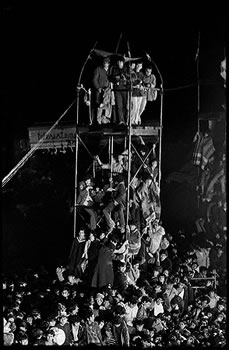 |
|
Pedro
Meyer © 1971 Avandaro Festival- Mexico
|
If this
is the case, we need to look in the right place to evaluate such a
future for film. We would do well to stop viewing these matters from
the romantic and nostalgic perspective of something that we had gotten
used to using. Where, some view these issues with a strong passionate
attachment. But think about it, even if you love film, if sufficient
numbers of people take to digital photography as the numbers tell
us, film is not going to be around forever. Isn’t VHS on the
way out also, replaced by DVD’s?
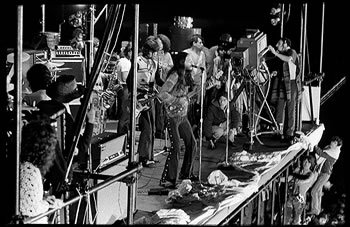 |
|
Pedro
Meyer © 1971 Avandaro Festival- Mexico
|
The movie
industry is moving in the direction of replacing film with digital
solutions to supply their theaters with the needed materials for projection.
Instead of sending expensive cans of films to thousands of theaters,
to which one needs to add the cost of transportation, let alone the
logistics of having the films in the right place at the right time,
etc. As soon as some theater chains start to make the transition to
digital, the flood gates are opened, because for the most part the
technology is already there to have such digital transmission. We
are also getting news daily of new feature length films that are being
shot entirely with digital cameras and no more film.
The medical
establishment is also moving away from film based x-rays. All this
would leave as the main outlet for film, the amateur photography market.
Needless to say, the professional market all together worldwide is
really a trivial consumption number for film manufacturers, that is,
compared to that of amateurs. You already have seen how ID pictures
have been replaced by Polaroid offerings, which in turn will be replaced
by inkjet solutions and digital cameras. School yearbook pictures,
a big industry throughout the world, is going digital as well. Then
we have most major newspapers also through out the world moving into
the digital realm.
This
last year digital cameras have outsold for the first time ever, film-based
cameras. The turf for film based cameras that used to be still photography,
has now also been invaded by digital video cameras, which double up
as still cameras while allowing us to make video as well.
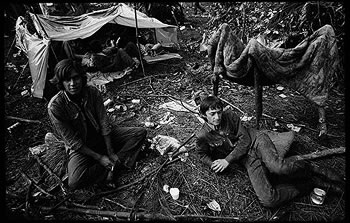 |
|
Pedro
Meyer © 1971 Avandaro Festival- Mexico
|
The technology
to replace film is advancing at an ever increased pace, so much so,
that new digital camera models are rolling out faster than we can
read the manuals of how to use them. There is not a single traditional
camera manufacturer who has not been getting their feet wet in the
river of digital cameras coming out of everywhere, it seems that today
the camera industry is no longer defined by the traditional film based
camera makers of yesterday. You have new names such as Sony, Hewlett-
Packard or Epson, making cameras, just to name a few. Minolta, one
of the world leading camera manufacturers just announced that they
are moving all their R&D (research and development) money from
their APS ( Advanced Photo System) film based technology over to digital,
because that is where they see the future.
Who would
have thought that the market valuation (the total amount of shares
outstanding by a certain company, multiplied by the market price of
those shares at a given time) of that venerable bastion for the production
of film, called KODAK, is lower than that of Apple Computer, Inc.
With these numbers the market is telling us that the future for Kodak
is much less promising than that for Apple. Historically the leader
in one era does not lead the charge into the next one. So far Kodak
has fumbled from one digital solution to the next, as they never really
wanted to embrace with much enthusiasm a future that would cannibalize
their previous breadwinners. One might have empathy and understanding
for their predicament, but the competition is relentless and unforgiving.
If the issue were up to Kodak alone, I am sure there would be film
forever, but they are not the only ones defining such a reality, thus
we have to look at the larger picture.
We have
to ask ourselves if we will be well served or not by these projections.
Obviously the photographers who love film will never agree that this
possible demise of film is anything other than a disaster.
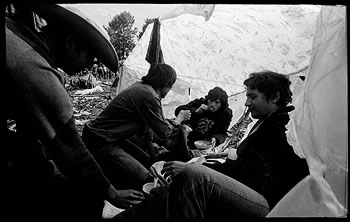 |
|
Pedro
Meyer © 1971 Avandaro Festival- Mexico
|
I have
been working now with digital solutions for the past fifteen years,
and all I can say is that I am mesmerized, every day anew, at the
potential and the unending array of possibilities that accrue to those
who have taken the leap into the world of digital production. The
last time I used my darkroom was 12 years ago, and have never had
to look back a single day.
A University
that is reorganizing their facilities to teach photography to 400
students approached me recently. They wanted to know how best to set
up their traditional dark rooms. I looked at them, and asked whom
are these students going to work for when they get out of college
in 4 years? Because I want you to know that the number of places where
they can go to work after they graduate, that will still be using
the traditional methods of production is going to slowly disappear.
How can you in good conscience train them with technologies that are
no longer going to be used? Was my question to them? They got the
message, and will probably move over to digital technologies because
they need to train people for the future not the past. Think of the
advertising world, the printing industry, newspapers, editorial industry,
news media, they are all going digital.
So how
long will film be around? I don’t envisage for very long, if
you think of the new FOVEON technology that has just been brought
to market with chips that offer even higher resolution than film,
and doing so at prices almost to the level of the consumer market.
Even Kodak has singed up for these new chips, to introduce them in
their line of cameras.
So do
yourself a favor, if you haven’t already done so, start exploring
with digital cameras.
Don’t
worry if this is the right time, or if it is better to wait for a
better camera later on, rest assured that the moment you bought any
new digital camera it was already obsolete the moment you purchased
it, you cannot get ahead in this game. What you can do is get ahead
in your own game, and that is to learn as fast as possible all that
these new technologies have to offer. You will have much to gain from
doing so.
I just
finished printing some images that I took during the first Woodstock
like Rock Festival we had here in Mexico, 31 years ago (the pictures
in this editorial belong to this body of about 50 images). This work
has never been seen, because when I took the pictures at the time,
all I could afford to use was bulk film. Unfortunately that process,
scratched the film while loading it into the canisters that would
go into my camera, I had some interesting images, but the negatives
were unusable to print from because of those ugly dark lines running
across the entire picture. In addition some of these negatives were
over exposed or under exposed, (we then worked with no automatic exposure
meters). They were unusable as I wrote, that is, until today when
with digital technology none of these problems mattered any more and
I could salvage all that work.
Please
share with us your points of view. I am sure you will have much to
contribute to this debate.
Pedro
Meyer
Mexico City
February 2002
For
comments post a message in our forum
section at ZoneZero.
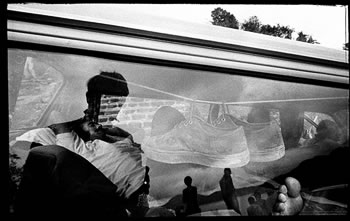 |
|
Pedro
Meyer © 1971 Avandaro Festival- Mexico
|
|
